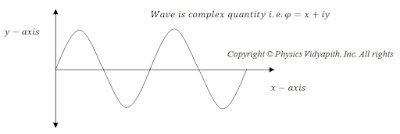Periodic motion:
If a particle repeats its motion or path at a regular interval of time, it is known as periodic motion.
Simple Harmonic Motion:
Simple harmonic motion (S.H.M.) is a specific type of periodic motion. In the simple harmonic motion, the force (i.e., restoring force) exerted on the particle is directly proportional to its displacement from the equilibrium position and acts in the opposite direction to that displacement.
Wave:
A wave is the combination of infinite simple harmonic motion equations.
Mathematical Equation:
Let us consider a particle that is doing simple harmonic motion in a circular path with radius $A$. Let at any instant $t$ particle move from position $P_{1}$ to $P_{2}$. So vector resolution of position $P_{2}$ is (as shown in the figure below):
Horizontal Component i.e. $x$ component of position vector $P_{2}$:
$x=A sin(\omega t - \phi) \qquad (1)$
Vertical Component i.e. $y$ component of position vector $P_{2}$:
$y=A cos (\omega t - \phi) \quad (2)$
 |
| Simple harmonic motion of a particle |
According to Max Born's hypothesis-
"A wave is described by a wave function $\varphi$, which is mathematically expressed in the form of a complex quantity."
So mathematical representation of a wave function
$\varphi= x+iy \qquad (3)$
Now put the value of $x$ and $y$ component in the above equation-
$\varphi= A sin (\omega t - \phi)+ i A cos (\omega t - \phi) $
$\varphi=A [sin (\omega t - \phi)+ i cos (\omega t - \phi) ]$
$\varphi=A e^ {i(\omega t - \phi)} \qquad (4)$
Where $\phi$is the phase of the wave. The value of $\phi$ can be found by the relation between the phase difference and path difference of a plane progressive wave.
$\phi =\frac {2\pi}{\lambda}\cdot x $
$\phi = k\cdot x$
Now put the value of $\phi$ from the above equation into equation $(4)$. So the wave function equation can be written as
$\varphi (x,t) =A e^ {i(\omega t - k \cdot x)} \qquad (5)$
 |
| Propagation of a wave along the x-axis |
Let us consider a particle having mass $m$ that is in motion along the positive x-direction with momentum $p$ and total energy $E$. So the wave function equation $(5)$ in terms of momentum and total energy
$\psi(x,t)=Ae^{-i\omega (t-\frac{x}{v})} \qquad(6) $
$\psi(x,t )=Ae^{-i(\omega t-kx)}$
$\psi(x,t )=Ae^{i(kx-\omega t)} \qquad(7)$
According to Planck’s hypothesis-
$E=h\nu \qquad(8) $
$E=\frac{h}{2 \pi }\cdot 2 \pi \nu$
$E=\hbar.\omega$
$\omega=\frac{E}{\hbar } \qquad(9)$
According to de Broglie hypothesis-
$\lambda= \frac{h}{p}$
$p =\frac{h}{\lambda }$
$p =\frac{h}{2 \pi }\cdot \frac{2 \pi}{\lambda}$
$p=\hbar\cdot k$
$k=\frac{p}{\hbar}\qquad(10)$
Now put the value of $\omega$ and $k$ from equation $(9)$ and equation $(10)$in equation$(7)$
$\psi (x,t)=Ae^{ i(\frac{p}{\hbar }x-\frac{E}{\hbar }t)}$
$\psi (x,t )=Ae^{\frac{i}{\hbar}(px-Et)}$
The equation for the three-dimensional $(3D)$ wave function of a free particle:
$\psi (\overrightarrow{r},t)=Ae^{\frac{i}{\hbar}(\overrightarrow{p}x-Et)}$



